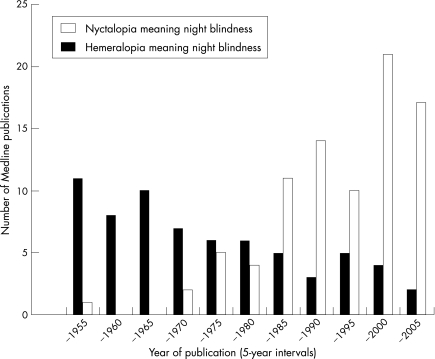Nyctalopia and hemeralopia are the rare examples of words that may lead to a good deal of controversy and confusion among doctors of different linguistic backgrounds, because of different definitions and meanings. Nyctalopia is a word from the Greek medical antiquity, defined as “night blindness” or defective dark adaptation.1 Hemeralopia is a word that originated in the 18th century, which means “day blindness” or visual defect characterised by the inability to see as clearly in bright light as in dim light.2,3 Standard English dictionaries also conform with the meanings of nyctalopia and hemeralopia as night blindness and day blindness, respectively. However, the words have been used in an opposite sense by many non‐English‐speaking doctors.4 To reduce confusions, it is recommended that correctly understandable terms such as night blindness and day blindness be used.5 Curious about the current compliance with this recommendation, we performed a search for the words nyctalopia and hemeralopia in the title and abstract of original articles and case reports in English included in Medline, provided by PubMed. We retrieved 167 publications that were published between 1951 and 2005. Each retrieved article was examined to determine whether nyctalopia is used to mean night blindness or day blindness, and hemeralopia to mean day blindness or night blindness. Table 1 summarises the results.
Table 1 Usage of nyctalopia and hemeralopia in Medline publications*.
| Language in publication | Nyctalopia to describe night blindness | Hemeralopia to describe day blindness | hemeralopia to describe night blindness |
|---|---|---|---|
| English | 72 | 14 | 10† |
| French | 0 | 0 | 25 |
| German | 6 | 0 | 11 |
| Italian | 0 | 0 | 7 |
| Dutch | 0 | 1 | 0 |
| Spanish | 0 | 0 | 1 |
| Portugese | 0 | 0 | 1 |
| Polish | 3 | 0 | 0 |
| Other Western Europe | 0 | 0 | 9‡ |
| Japanese | 2 | 0 | 0 |
| Chinese | 2 | 0 | 3 |
| Total | 85 | 15 | 67 |
*Medline search for original articles and case reports published until 2005.
†Country of origin: Germany 4; Italy 2; Israel 2; Norway 1; Finland 1.
‡Language of publication: Russian 4; Czechoslovakian 2; Hungarian 1; Polish 1; Rumanian 1.
The word nyctalopia was used in 85 articles (English, 72 articles; non‐English, 13 articles). All these articles used the word aptly to describe night blindness in patients with stationary night blindness, vitamin A deficiency, retinitis pigmentosa and Usher's syndrome, among others.
The word hemeralopia was used in 82 articles (15 of them meant day blindness and 67 of them meant night blindness). The 15 articles with apt usage of the word hemeralopia were mostly written in English to describe cone dystrophy, cone dysfunction syndrome and Stargardt's disease, among others. The remaining 67 articles with incorrect usage described night blindness in patients with retinitis pigmentosa, choroideraemia, vitamin A deficiency, myopia–night blindness, congenital stationary night blindness and fundus albipunctatus cum hemeralopia, among others, and they originated from non‐English‐speaking countries, including France, Germany, Italy, Israel and China. Of the 67 articles with the incorrect usage of the word hemeralopia, 10 were written in English and the remaining 57 were in non‐English languages.
There was a decreasing trend of usage of the word hemeralopia and an increasing trend of usage of nyctalopia to describe night blindness (fig 1).
Figure 1 Medline publications using the word nyctalopia to describe night blindness and those using hemeralopia to mean night blindness. The number of articles was summed over 5‐year intervals between 1951 and 2001. White bars: articles that used the word nyctalopia to mean night blindness; black bars: articles that used the word hemeralopia to describe night blindness.
The results confirm that the word hemeralopia, but not nyctalopia, has been used incorrectly in the literature among non‐English‐speaking countries. However, currently, there is an improved trend of compliance with the recommendation that correctly understandable words such as night blindness and day blindness be used instead of the controversial nyctalopia and hemeralopia, respectively.
Footnotes
Competing interests: None declared.
References
- 1.Brouzas D, Charakidas A, Vasilakis M.et al Nyctalopia in antiquity. A review of the ancient Greek, Latin, and Byzantine literature. Ophthalmology 20011081917–1921. [DOI] [PubMed] [Google Scholar]
- 2.Skinner H A. The origin of medical term. 2nd edn, New York: Hafner Publishing, 1970
- 3.von Hommer K. Die Hemeralopie als Leitsymptom hereditärer Augenleiden. Wien Klin Wochensch 196724476–479. [PubMed] [Google Scholar]
- 4.Duke‐Elder S. Functional defects of vision. In: System of ophthalmology. Vol III. Normal and abnormal development. London: Henry Kimpton, 1964657–668.
- 5.Online Mendelian Inheritance in Man, OMIM (TM) McKusick‐Nathans Institute for Genetic Medicine, Johns Hopkins University (Baltimore, MD) and National Center for Biotechnology Information, National Library of Medicine, Bethesda, MD, 2000. ( http://www.ncbi.nlm.nih.gov/omim/(accessed 10 Oct 2006)



